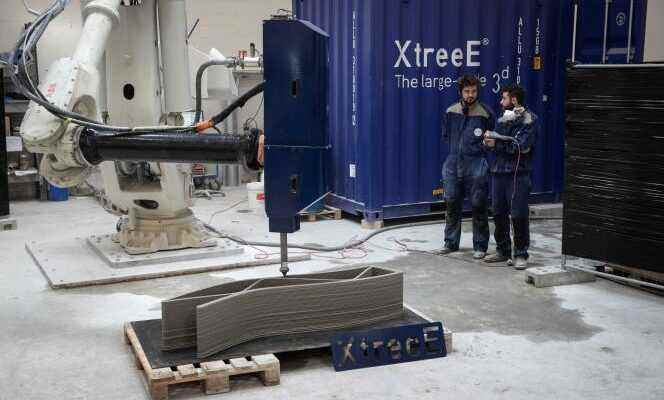The move of Rochdi Zardi, 60, to one of the five houses bordering the eco-district of Reims, in the Marne, marks first of all a small personal victory: for more than a year, this former supermarket manager was looking for accommodation adapted to his wife’s disability, in a wheelchair. At the beginning of July, he will leave a 4e floor for a single storey with terrace and garden. But the new beginning of this family is also the pride of the social landlord Plurial Novilia, of the young shoot XtreeE, and of a whole team which, after more than four years spent chasing after technical advice and certifications, have just handed over the keys to the first five 3D-printed concrete houses in France.
These days, the visits multiply before the arrival of the tenants. The aim is to show the profession what this new technology allows. Innovation can be seen on the south side. Curved in shape, left in their raw state, the non-load-bearing walls of the living room and the two bedrooms are made of a stack of light gray concrete cords placed horizontally. These are the walls that were “printed” by a robot, 170 kilometers away, in the hangar of the start-up XtreeE in Rungis (Val-de-Marne), then transported by truck to Reims, assembled using a crane, before being lined with rock wool.
The team boasts an economy of material and the absence of waste. Above all, the site is cleaner, faster, less tedious and is part of this renewed interest in off-site construction, the golden age of which remains the post-war period, with the advent of prefabricated. Thanks to this technique, the cost of which remains 25% higher than traditional laying, masons no longer carry their daily ton of concrete blocks, sand and mortar; the robot does everything. Jérôme Florentin, director of project management at Plurial Novilia, sees it as a way of upgrading the building trades.
On this project, thirty-five walls, all different, but high and wide on average 3 meters, were made. Count five hours for the largest. “We know how to print five to seven walls per week, so one house per week. It’s so fast that even the yard can’t keep up.”explains Alain Guillen, director of XtreeE, in the hangar at Rungis.
Build higher
The difficulty has been to find the right texture, the right formulation, so that the concrete thread that comes out of the printhead is sufficiently fluid but also dries in record time so that it does not sag under its own weight when the robot, guided by a mechanical arm, lays the next bead, less than a minute later.
You have 34.65% of this article left to read. The following is for subscribers only.
